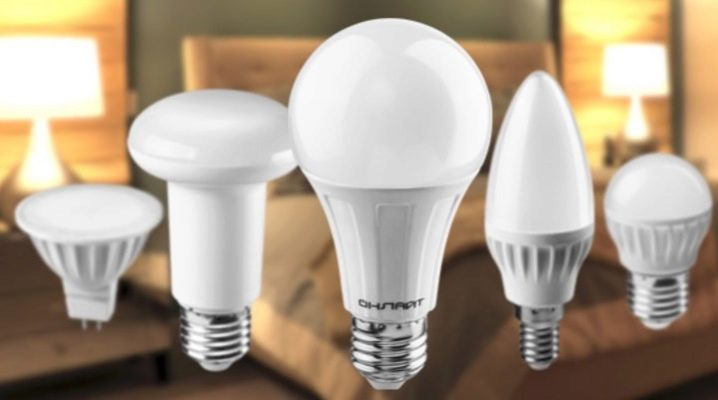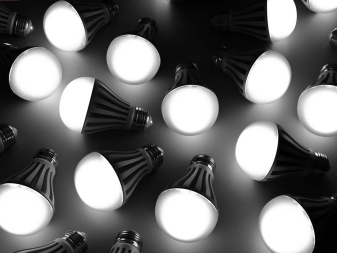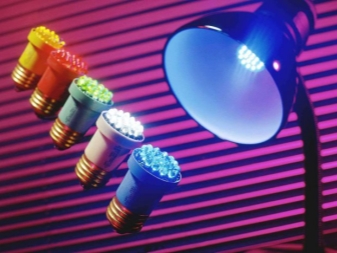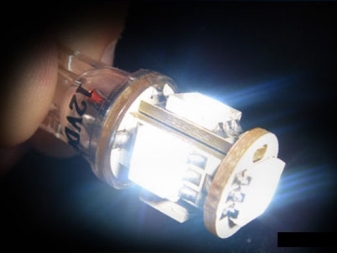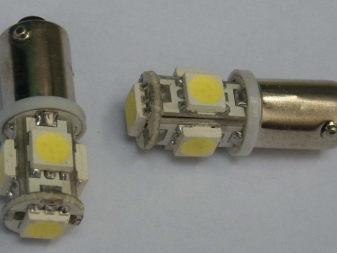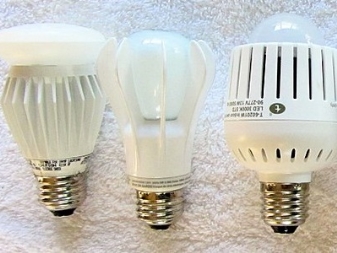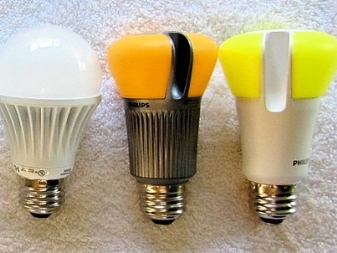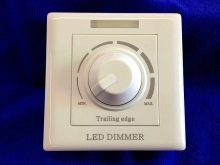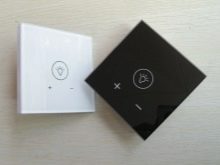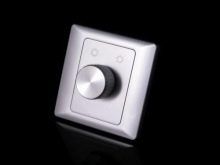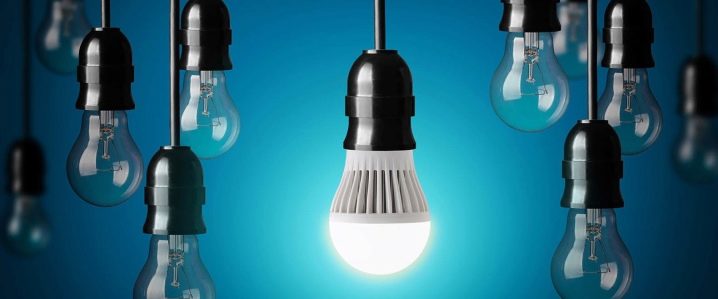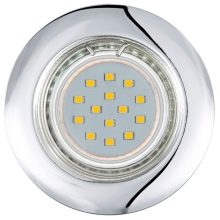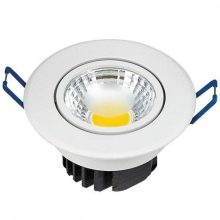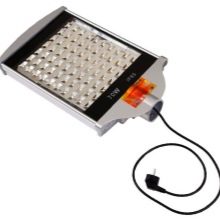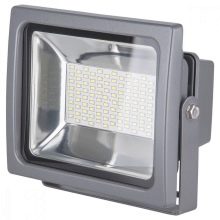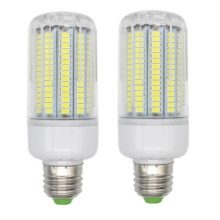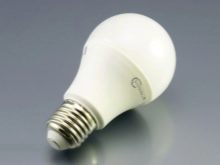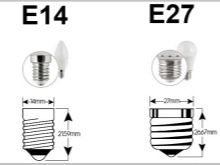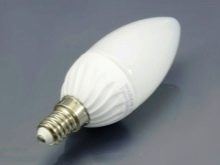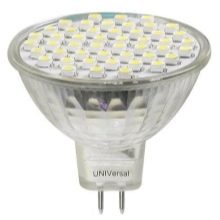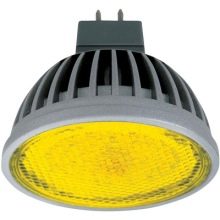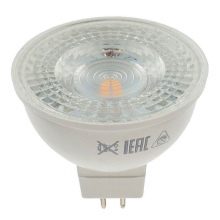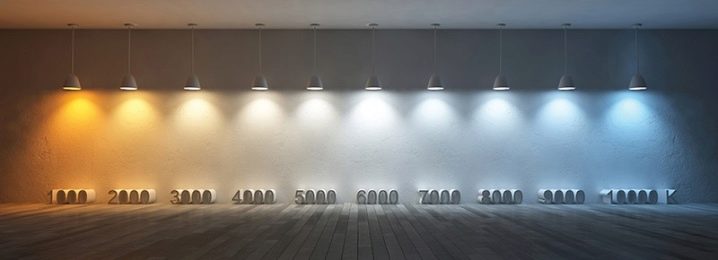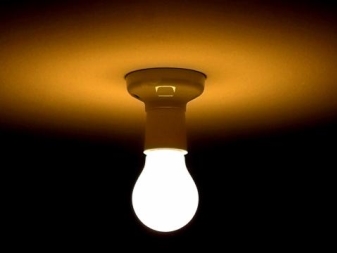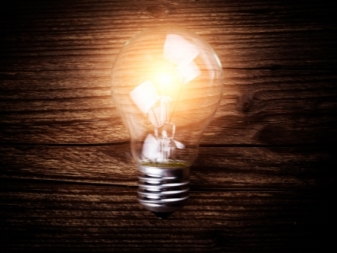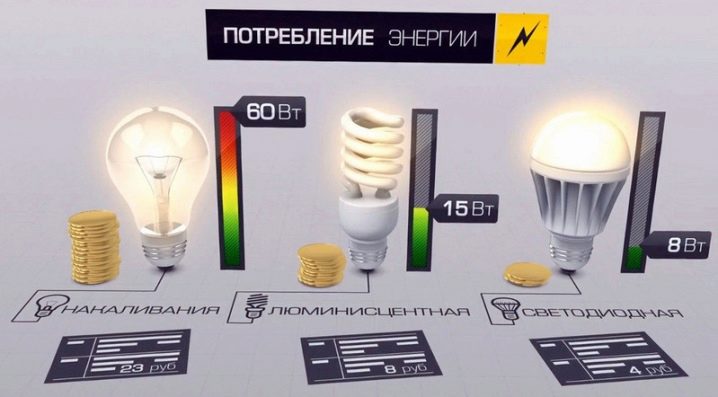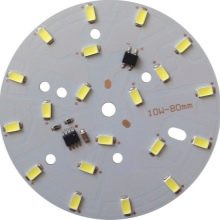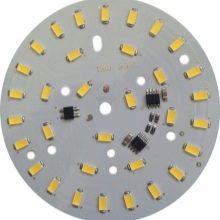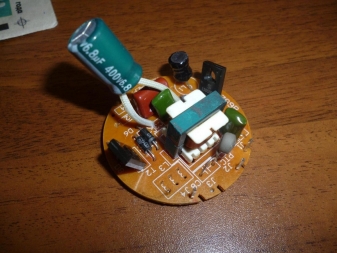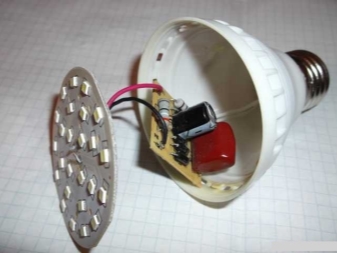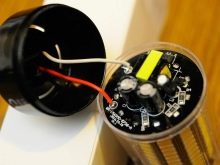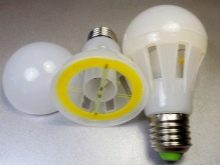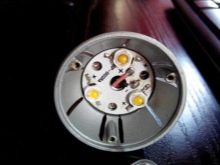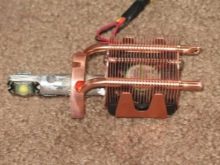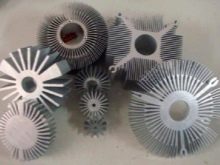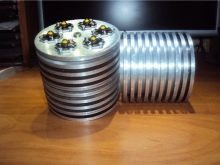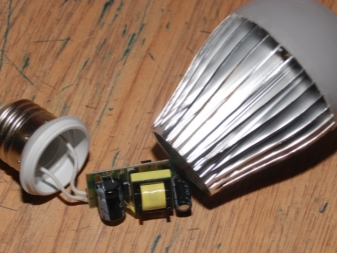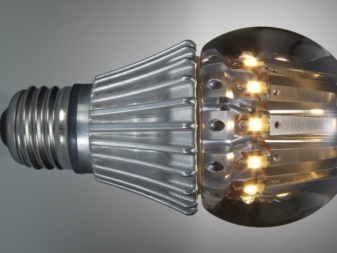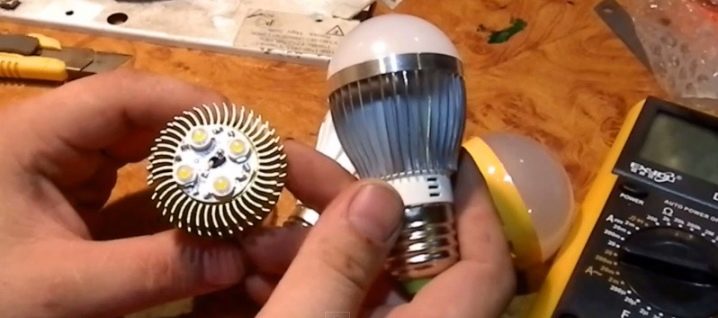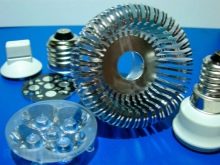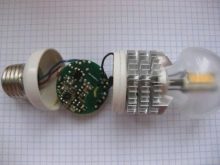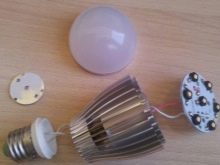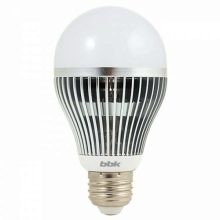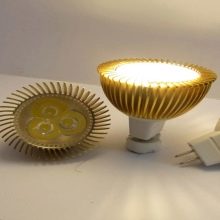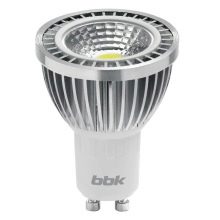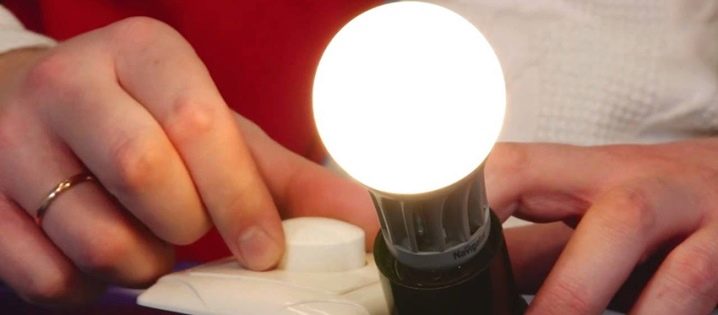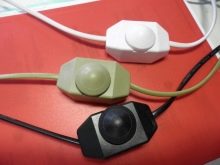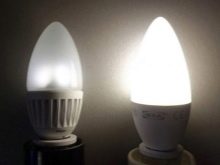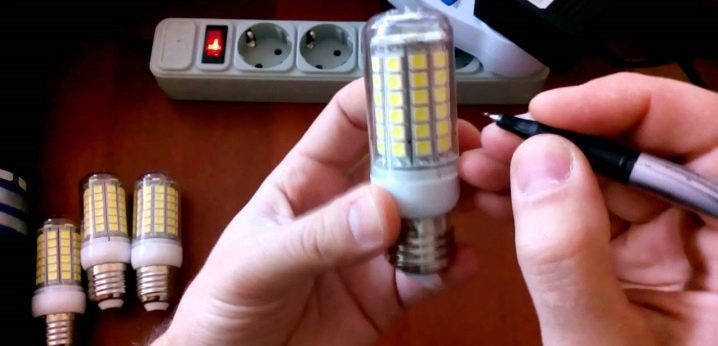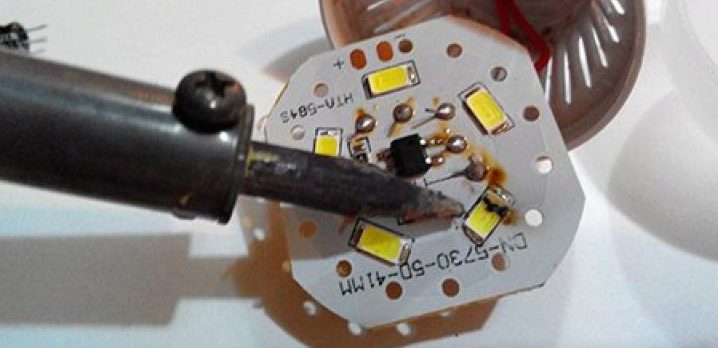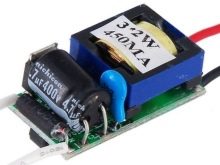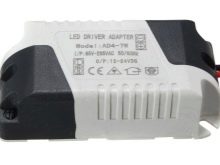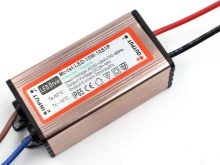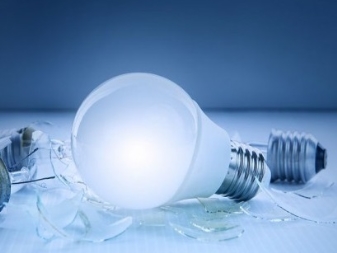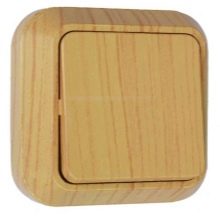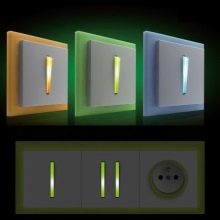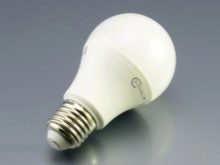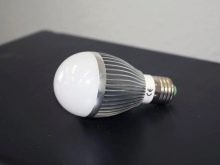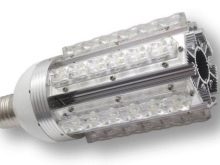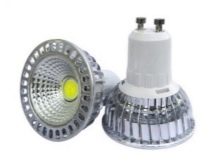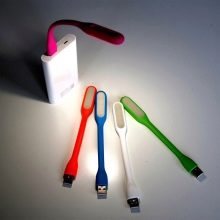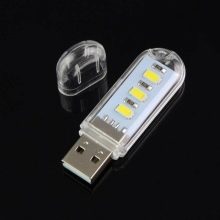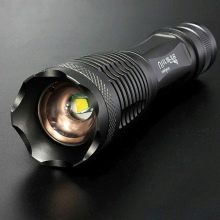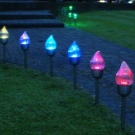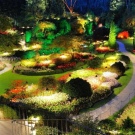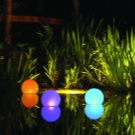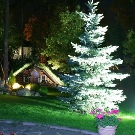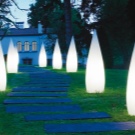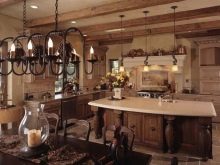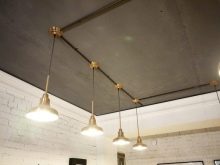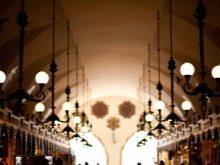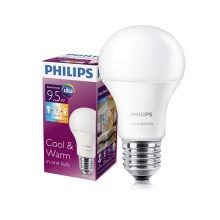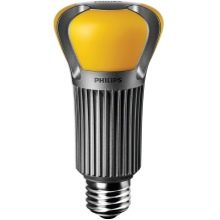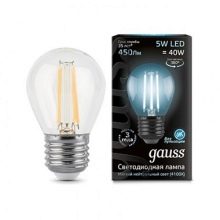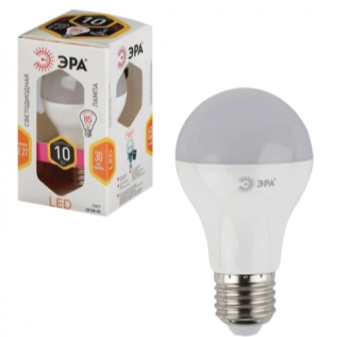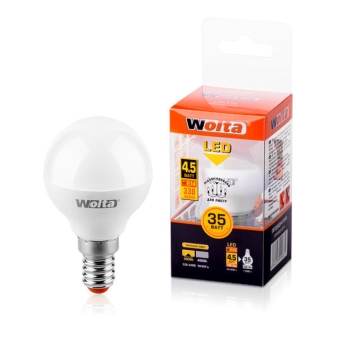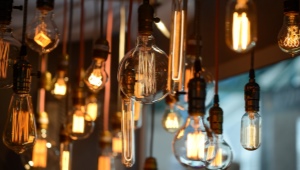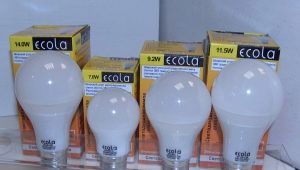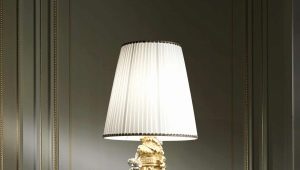LED bulbs
At the present stage one of the most economical light sources are LED lamps. Due to the fact that the scope of their application is very wide, such lamps can be used everywhere: at home, on the street, in industrial plants. After the purchase, they will soon be repaid, because energy savings increase many times over. In this regard, LEDs significantly “overtake” even luminescent light sources, which, as is well known, have replaced ordinary incandescent lamps. In order to understand which LEDs should be acquired and what should be oriented, it is necessary to understand the basic principles of their work and those indicators that will help to ensure the best degree of illumination in a particular room.
Advantages and disadvantages to use
All LED light sources are energy-saving and, as already mentioned, can save much more electricity than with incandescent lamps or luminescent analogues.LEDs are much better and higher than other light bulbs in terms of light output, moreover, they have a much quieter luminescence that does not blind and does not tire the eyes for a long time, even if we are talking about powerful enough lamps or searchlights used in industrial plants.
Unlike fluorescent and incandescent bulbs, there are no dangers or problems with LEDs if they are disposed of: they do not contain such a dangerous chemical element as mercury, and therefore they can be safely thrown out without any special procedures, of course, observing the safety technique when handling glass.
As you can see, the advantages of LED lamps are very significant, but along with them, it is worth noting the disadvantages that also have a place and they need to be considered in the event that the buyer decided to purchase economical, but specific LEDs of a kind. Surely at cost, they are several times higher than even luminescent analogues: in stores it is rare to find a light bulb, the price of which would be less than 300 rubles. If high-quality products, its cost is often much more than this figure.
LED lamps have the function of working with a dimmer - a regulator of the intensity of the flow of light.However, you should be aware that it is not easy to pick up a suitable dimmer, and, if necessary, you will have to spend a certain amount of time on its correct choice in order for the lamp to work as correctly as possible. You also need to keep in mind that LEDs are very sensitive to voltage drops in the network.
And of course, practice shows that in many places low quality lamps are offered that fail very quickly.
However, given the indisputable advantages, most of these "minuses" should still be perceived not as disadvantages of LED lamps, but as their features, which will have to be taken into account when purchasing. If you approach the issue sensibly, most of these technical issues can be solved, and the lamps themselves will serve for a long time and with tremendous energy savings.
Types
At the mention of LED lamps from an unknowing person, the question may arise as to how they look and what they are. A novice consumer will surely be surprised but most of these structures are not very different from the usual household sources of electric light:
- For example, tubular led lamps manufactured to replace fluorescent light sources of a similar type and are now widely used for lighting in industrial premises, offices and hypermarkets. Long narrow flasks are both opaque and transparent, and now they are made not from ordinary glass, but from high-strength polymeric materials.
- Spotlights also very widespread. They are used for the so-called "point" lighting stretch ceilings in all rooms. They are the best option, because they do not heat the materials of which the ceiling is made, and perform not only the lighting, but also absolutely safe aesthetic function of lighting. Spot lighting using LEDs is also found in the design of various kinds of creative spaces and photo studios.
- For outdoor floodlights The use of LEDs has become a kind of salvation due to the fact that such a projector consumes a much smaller amount of energy, and the brightness of the light flux required for street lighting becomes much higher.
If the LEDs in the searchlight are arranged in a dotted manner (there are several of them in the design), when the system fails, any LED can be easily replaced, and the work of the searchlight will be fully restored.
Main settings
LED lamps have different types of socles. Socles E27 and E14 connected to the thread in the usual classical way, which makes these lamps look like the most standard ones. The presence of a digit in the name of the cap indicates the size of the diameter in millimeters. GU10 - base with two-pin connector, extending closer to the ends of both pins, the distance between which is 10 mm. Such a base is considered the safest and is designed for a voltage of 22 volts.
GU 5.3 - Also pin model of the base, only more modern versions. This type of cap was used to design halogen lamps, but now it is successfully installed in LED lamps. This type is very convenient when installed on plasterboard surfaces. G13 used in linear type lamps, having the form of long tubes with two noticeable pins at one end, the distance between which is, respectively, 13 mm.
The power of LED lamps is an important indicator.This is the amount of energy consumed by a lamp for a certain unit of time. In other words, if the lamp has an inscription of 12 watts, it means that it consumes 12 watts per hour. If you make a table of power and compare its performance, for example, with a fluorescent lamp, the difference will be obvious.
For example, a 2-watt LED lamp is equal to a 20-watt incandescent lamp in all basic functions, while it consumes 10 times less energy per hour. If we compare the power indicator with a similar luminescent light source, the power of the fluorescent lamp will be less than that of a 6W incandescent lamp, but any LED will still come first because of the enormous energy savings.
Light output is the actual amount of light given off by the lamp. It is measured in lumens. For example, lamps from different manufacturers with the same power consumption can have completely different light output (850,900, 950 lumens, etc. ).
As an example, you can take a simple comparative indicators of light output, which can give different types of lamps. For example, a standard 15-watt incandescent lamp gives a luminous flux of 135 lumens.For comparison, a fluorescent lamp with a power of 5 W has a light output of already 145 lumens. This figure is already much better, but the LED lamp and here is ahead of all in terms of energy saving and brightness: at a power of only 3 watts, its luminous flux is as much as 360 lumens.
The color of the light flux in the LED lamp may be different and be able to regulate the color spectrum. This is one of the main differences between LEDs from incandescent bulbs, which always give a monochrome yellow glow. Color temperature (or glow temperature) is measured in kelvins. It affects the comfort and convenience. There are four European standards of temperature: 3000 Kelvin is a warm light, 4100 Kelvin is neutral, 5000 is cold, 6500 is industrial light. The last color temperature is prohibited to use in domestic premises.
The color rendition index, as a rule, is always written on the outer side of the cardboard packaging of light bulbs, or its indications can be found in the attached technical data sheet.
Incandescent bulbs always emit light at the same angle. As for the LEDs, they can give a luminous flux at different angles, which should be considered when purchasing one or another type of lamp.The radiation angle may be small. In this case it is a question of a narrowly directed stream of light, when a small area will be illuminated. (VNSP). FL - the flow is small, but wider than the previous figure, and the combination of letters Vwfl on the packaging or in the passport of the lamp indicates a wide scattering angle.
Lamp energy efficiency is the ratio of its light output to power consumption. It is measured in lumens per watt. For example, the energy efficiency of the lamp "Sirius" with a light output of 960 lumens and a power consumption of 10 watts will be 96 lumens per watt. The higher the energy efficiency indicator, the better the lamp shines.
Some people think that the higher the temperature of the glow, the brighter the light comes on, but this is absolutely wrong. The light output is affected by the light output of the lamp, and not by its light temperature at all.
Device and principle of operation
The LED lamp includes four main parts. This bulb with a diffuser, LED board, driver and base housing with base.
Flasks with a diffuser are matte and transparent. They are made of glass or plastic. Plastic bulb with a matte diffuser is used absolutely in all types of lamps.A flask with a glass diffuser is used only in decorative lighting.
Board with LEDs, as a rule, has an aluminum substrate, on which the LEDs are applied. In the lamps of domestic series use two types of LEDs. The first type is Deep with low light output. Second - SMD, today it is more common in the application.
The LED board is powered by the driver. It converts the alternating current of the 220-volt network into a direct current, thanks to which the light bulb does not burn out when voltage surges occur in the network. Inherently the driver is the “heart” of the entire product which affects the level of quality and quantity of light, as well as the life of the lamp. The driver board includes a capacitor and a transformer. The capacitor "quenches" the pulsating voltage, and the transformer converts it.
And the last element is the body of the lamp, made of aluminum and high-quality plastic, which provides a good heat sink and, as a result, increases the duration of the light bulb.
additional characteristics
It is important to note that in addition to the basic four elements of the design of the LED lamp, it must also have a radiatorwhose role is equally important.It deserves a separate description, since it is he who provides the level of heat dissipation in the lamp. There is a radiator in its case, and its device may vary depending on the level of quality of work performed by the manufacturer.
The radiator position is between the body of the bulb and its base. As is well known, a diode itself, with strong heating, can lose its properties due to the destruction of its crystals: the faster it occurs, the stronger the light output of the lamp falls and it becomes duller. In the worst case, the diode can simply burn out and have to be replaced, and in the worst case, if the more capacious parts of the circuit fail and the impossibility of restoring them, the light bulb must be disposed of.
There are two main types of radiators. In cheap light bulbs install light plastic radiators with a film coating. Such a primitive design is not able to remove heat well and keep the diodes in good condition. The most annoying thing is that when a person buys a light bulb, it cannot visually determine which radiator is placed inside it.Sometimes you can test a light bulb by gently tapping on the outside with its small metal object.
The characteristic sound sometimes helps to understand what material the radiator is made of. But this method can be effective and accurate by no means always, given the variety of product design.
It is important to know that if the LED lamp is of good quality, then the radiator installed inside it will be made of durable aluminum or variants of its alloys. The fins of such a radiator always have the shape of a spiral and varying degrees of length, which, in terms of the elementary laws of physics, provides the most efficient and reliable heat removal from fragile diodes due to the good circulation of the airflow inside.
If the method of tapping a light bulb turned out to be ineffective, the buyer can orient at the price: the better the radiator, the higher the price of the product and the stronger its external design looks. Buying cheap LED lamps, you should not expect that the radiator installed in them will properly perform its necessary functions.
How to connect?
The easiest way to do it with your own hands is to connect an ordinary LED strip: it will never be superfluous in the room where an additional light source is required. The wiring diagram is very simple. To the 220 V network, the tape must be connected via a room transformer (voltage converter) with a power of 15 W to 3 m of the tape. The wiring from the tape is connected to the clamping terminals of the transformer with strict polarity (plus, minus). The transformer also has the designation of places in order to properly connect the "phase" and "zero".
After assembling the entire electrical circuit, you can immediately connect the device to the network and check its operation.
Room illumination standards
If you need to choose the right lighting for the workplace of a child of school age, it is important to consider both natural and artificial light sources. It is necessary to take into account where and how the table and the lamp itself will be located. The flow of light itself should be as soft as possible, without flickering. Any artificial lighting is always important to combine with natural - this will help minimize eye fatigue and their stress during work.It is important not only to choose the right parameters of the light bulb, but also to take into account the very design of the lighting device in which it is planned to be placed. Required condition - the ceiling light should cover the bulb to prevent direct light from entering the eyes.
Normally, the lighting standards for the student’s workplace are 300 lux. Lux is a common measure of luminous intensity. It is created by a flux equal to 1 lumen in a ratio of 1 square meter of the illuminated surface. The 300 lux limit will provide optimum lighting performance: smooth, calm light with minimal eye strain and the complete absence of annoying blink.
By the way, it is worth noting another important advantage of LED lamps: with the help of a special device - a dimmer, there is a great opportunity to adjust the brightness and intensity of light.
If the child gets tired and feels that his eyes are overstressed, he can independently learn how to regulate the right amount of luminous flux.
Possible faults and their elimination
If the LED bulbs burn out, do not rush to throw them away immediately. They can be repaired, and it is not difficult to do.The blown LED becomes immediately visible: it turns black or turns dark brown. The electric circuit of the LED light bulb is arranged as follows: if one of them burns out, the entire device stops burning, because all the LED elements in it are connected in series with each other.
One LED is the easiest to change. To do this, you need the same "donor light bulb", in which there are whole elements. The donor light bulb is carefully disassembled, and the LED is removed from it. This is done with the help of a building hair dryer and a soldering iron. You can immediately unsolder several LEDs, some of them will probably be working. The operation of sealed diodes is checked by measuring their voltage with a multimeter set to the “continuity” mode.
It is important to observe the principle of polarity: the red probe of the multimeter should touch the diode on the left (positive pole), and the black one on the right (negative pole).
If the sealed LED is normal and responds to the touch of the multimeter by burning, you can proceed to soldering it to the place of the burnt one. The light bulb is carefully disassembled (it should be borne in mind that the case is not always opened immediately, and when unwinding it sometimes you have to work hard, the main thing is not to break anything). Removing the board with LEDs.A non-working LED is soldered off with a preliminary application of a small amount of flux to the place of soldering. After the soldering is finished, you need to check whether the light is working without closing the wires. If everything works, the light bulb can be assembled and screwed into place.
Often we have to deal with such a problem in the work of LED lamps, as flickering. When the lamps flicker, it acts badly on the eyesight and on the entire nervous system as a whole, therefore this deficiency should be eliminated as soon as possible. In many cases, having precisely defined the reason, it can be done independently. The light may flash because it is simply installed incorrectly: in this case, all the contacts of the electrical circuit are checked and when weak contacts are detected, the circuit is fixed in the right place. Also one of the common causes of blink - power supply power does not match the lamp current. It is best to replace the adapter based on the power of the lamps used.
If the local network is constantly replete with voltage drops, despite the fact that the LEDs can be quite stable to them, the driver can not cope with this.In this case, you should look for problems in the local wiring, asking for help from specialists. There may also be a standard manufacturing defect of a light bulb during production: in this situation there is always the opportunity to exchange defective goods for a new one. The exchange is usually carried out while keeping the check.
Recently it has become very fashionable to use illuminated switches - this is beautiful, and it can always be seen in the dark. However, one should not use such a tempting type of switch if the lamps are LED: their specificity is such that they “glare” in response to an open circuit. The fact is that the constantly working illumination of such a switch does not allow the complete opening of the circuit, which is necessary so that the LEDs do not show their sensitivity. Unfortunately, in this case it is necessary to replace the backlit switch with a conventional one, and then the problem can be fixed.
Also, the backlit switch can cause the LED lamp to not just blink or flicker, but even remain on when the lights are off. The reason is the same: incomplete open circuit, and the backlit switch simply closes it to itself. At the same time, the light itself is not particularly bright, but even dim, but this too should not be. The output is the same: Replacing the switch with an ordinary one.
However, if you don’t really want to part with a beautiful switch, you can buy more expensive LED lamps, in which capacitors with large capacitance values will be installed. Such lamps can be fully paired with a backlit switch without any problems or interference.
Scope of application
In order to correctly identify the scope of a particular LED light bulb, you can just take a close look at the shape of its base.
Lamps with sockets were designed for lighting the house, apartment (any living space) E27 and E14. Base type E27 can be seen in the usual incandescent lamp, which is screwed into chandeliers, floor lamps, table light sources. In addition, this LED analogue looks almost the same, no different from the usual light bulbs. Base E14 It was also developed a very long time ago for “minion” type lamps intended for wall lights. Diode "minions" look very elegant and beautiful.
Overall lights with base E40 used to illuminate large spaces, for example, industrial warehouses, courtyards, streets. Double pin base G13 can be seen on the lamps in the form of a long tube - the same electrical sources of “daylight” used in large stores, offices, medical and industrial institutions. Base Gх53 designed for luminaires built into stretch ceilings made of plasterboard - it is this design that ensures the aesthetic appeal of such light bulbs and the simplicity of their mounting.
In stores, there are often small LED bulbs that are designed to work in some small battery-powered device, for example, a household flashlight or a portable desk lamp for technical purposes. They look quite fragile and require very careful handling.
Unusual models
The most beautiful and unusual models of LED lamps can be found in the field of decorative design of gardens, parks, summer cottages. Colored spotlights of various shapes and sizes (from round to elongated rectangular models) are installed to create a fabulous decorative lighting of trees and shrubs.Such a small spotlight can be easily hidden in the foliage, and it will not be visible at all. In addition, there is also LED lighting for facades and roofs of buildings.
Especially often it can be found in large cities: so highlighted theaters, museums, bridges, monuments.
Any LED light source can be easily designed for a retro version. Several lamps "antique" with a soft bluish color shade perfectly fit into the atmosphere of an old country house. This color will be pleasing to the eyes at any time of the day (not counting clear sunny days), and if you equip an ensemble of lanterns with the ability to control the intensity of light - with a dimmer, you will get useful lighting and a wonderful antiquity at the same time.
Rating of the best manufacturers
Certainly, LED lamps of such well-known companies as Philips and Gauss will always be in first place due to the impeccable quality of the goods, which is time-tested. But the price of such lamps is usually very high, and not everyone can afford to purchase. Therefore, you can pay attention to the production of lamps Russia.They are cheaper, but in no way inferior in quality to foreign manufacturers.
Firm Wolta produces good LED lamps with a three-year warranty, which can be purchased in retail stores or ordered online. Other Russian company - "Era", founded in 2004, is engaged in the supply and sale of all possible LED bulbs and light sources, ranging from street lamps to desk lamps.
About why LED lamps burn out, you can find out further.
